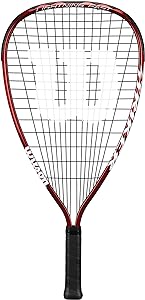Hockey Skates Vs Figure Skates: A Comprehensive Comparison
Hockey and figure skating are two of the most popular winter sports. Both sports require different types of skates, and it is important to understand the differences between hockey skates and figure skates. Hockey skates are designed for speed and agility, with a shorter blade that allows for quick turns and stops. Figure skates, on the other hand, are designed for elegance and grace, with a longer, flatter blade that allows for more stability and balance.
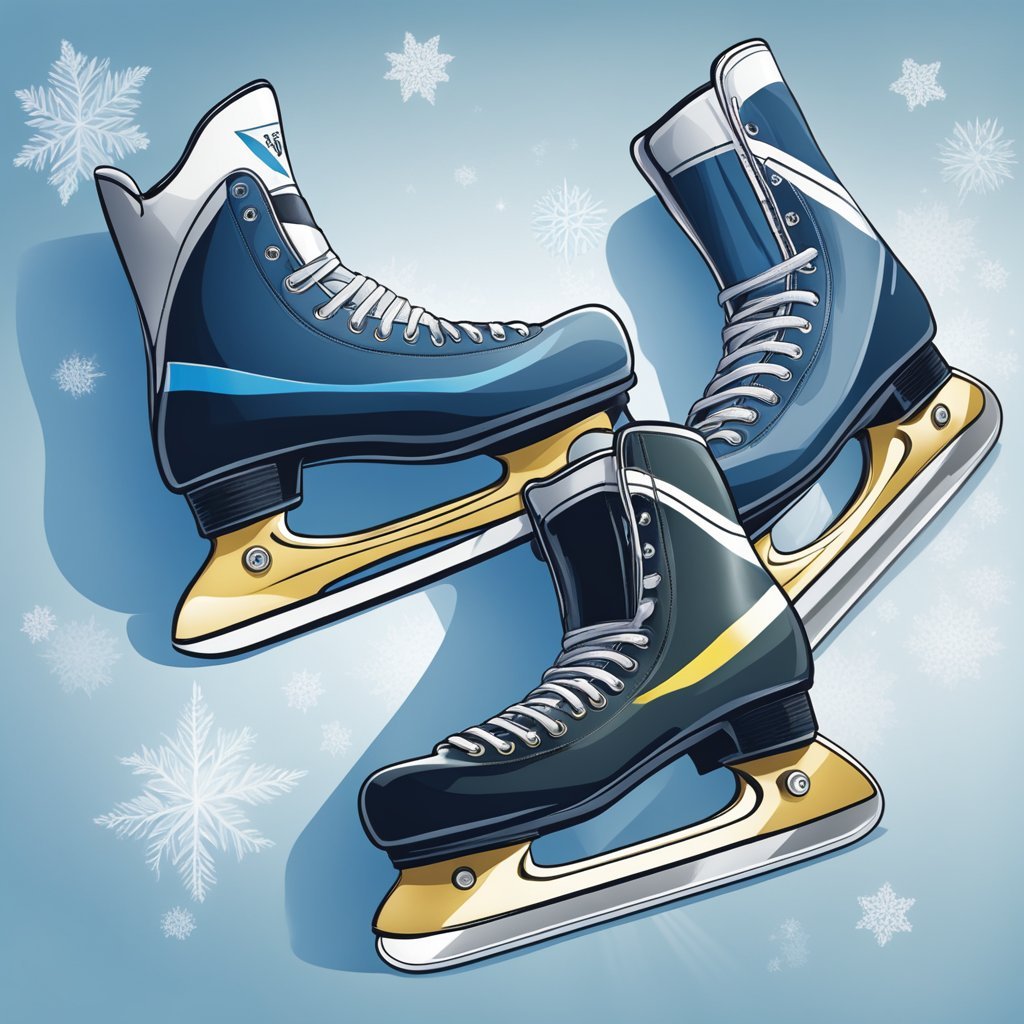
Table of Contents
Core Difference
One of the main differences between hockey skates and figure skates is the blade. Hockey skates have a shorter blade, which allows for quick turns and sudden stops. The blade is also curved, which helps players to move quickly and easily on the ice. Figure skates, on the other hand, have a longer, flatter blade that provides more stability and balance. The blade also has a toe pick, which is used for jumps and other maneuvers.
Another difference between hockey skates and figure skates is the boot. Hockey skates have a stiff, supportive boot that provides protection for the player’s feet and ankles. Figure skates, on the other hand, have a more flexible boot that allows for greater range of motion and a more graceful appearance on the ice. The material of the boot is also different, with hockey skates made from more rigid materials and figure skates made from softer, more pliable materials.
Design and Construction
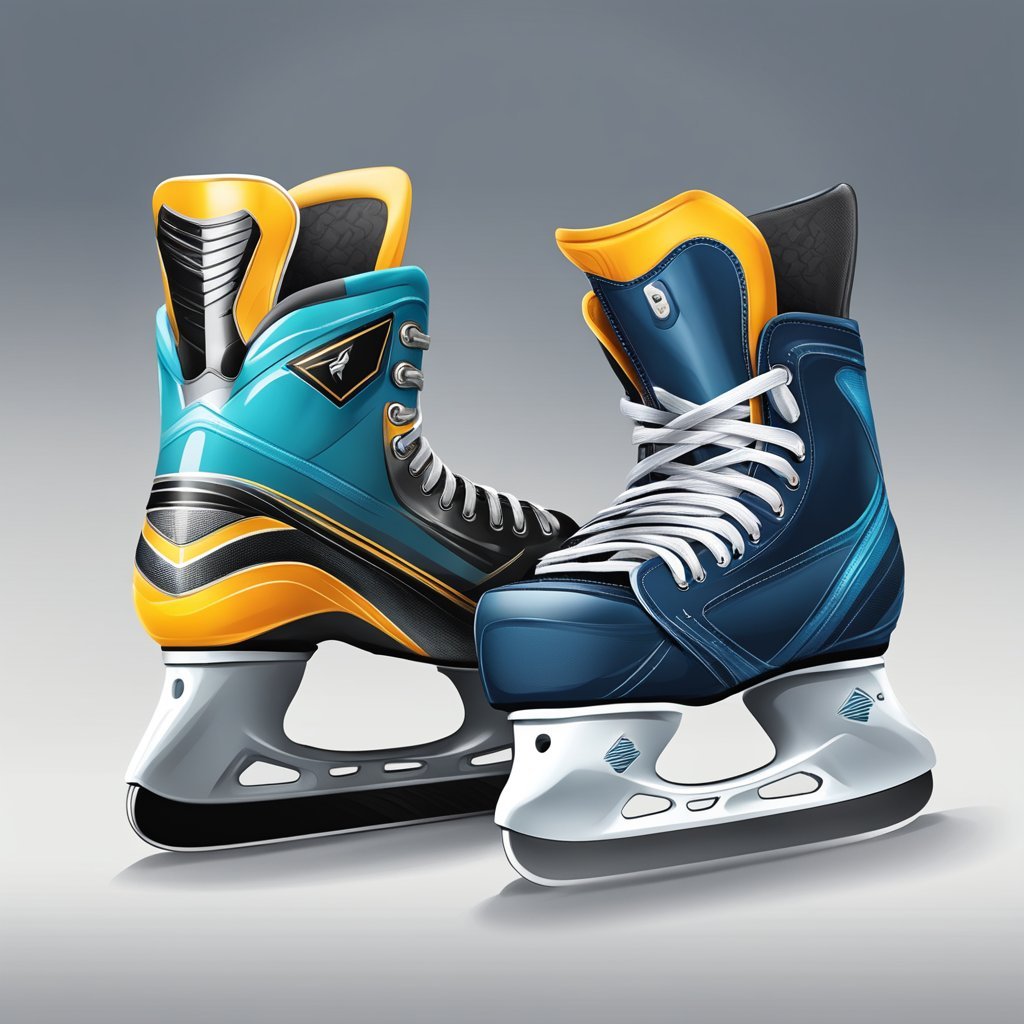
When it comes to design and construction, there are some key differences between hockey skates and figure skates. This section will explore the differences in boot construction, blade characteristics, and material and quality.
Boot Construction
Hockey skates have a rigid boot that provides excellent ankle support and protection. The boot is designed to be stiff, which allows for better control and power transfer. The downside to this design is that it can be uncomfortable for some skaters, especially those who are just starting out.
Figure skates, on the other hand, have a more comfortable boot that is made of leather or synthetic materials. The boot is designed to be more flexible, which allows for more freedom of movement. This is important for figure skaters who need to perform jumps, spins, and other intricate footwork.
Blade Characteristics
One of the biggest differences between hockey skates and figure skates is the blade. Hockey skates have a shorter blade that is designed for quick turns and pivots. The blade also has a rocker, which is a curved shape that allows for better maneuverability on the ice.
Figure skates have a longer blade that is designed for more graceful movements and precision. The blade also has a toe pick, which is a serrated edge at the front of the blade that allows for jumps and other tricks.
Material and Quality
The quality of the materials used in the construction of hockey skates and figure skates can vary greatly. Hockey skates are typically made of plastic, nylon, and foam, while figure skates are made of higher quality materials like leather.
The quality of the materials used in the construction of the skate can affect the overall performance and durability of the skate. Higher quality materials are typically more expensive, but they can provide better comfort, protection, and performance on the ice.
Overall, the design and construction of hockey skates and figure skates are tailored to the specific needs of each sport. Whether you are a hockey player or a figure skater, it is important to choose a skate that fits your needs and provides the necessary support and comfort for your feet.
Functional Differences
When it comes to functional differences between hockey skates and figure skates, there are several key factors to consider. This section will explore the differences in support and flexibility, balance and weight distribution, as well as mobility and maneuverability.
Support and Flexibility
One of the main differences between hockey skates and figure skates is the level of support and flexibility they offer. Hockey skates typically have a more rigid boot that provides the necessary support for the fast-paced, physical nature of the game. On the other hand, figure skates have a more flexible boot that allows for graceful footwork and artistic movements.
Balance and Weight Distribution
Another key difference between the two types of skates is the balance and weight distribution they provide. Figure skates have a wider blade that helps with stability for jumps and spins, while hockey skates have a narrower blade that helps with quick stops and tight turns.
Mobility and Maneuverability
Finally, the mobility and maneuverability of the skates are also important factors to consider. Hockey skates are designed for fast movement, agility, and quick turns, while figure skates are designed for precision, artistic elements, and intricate footwork. Hockey skates are also designed for physical contact, including body checks and blocking, whereas figure skates are used for solo or pair performances of jumps, spins, and intricate footwork.
In summary, the functional differences between hockey skates and figure skates are significant. While hockey skates offer more support, balance, and maneuverability for the fast-paced physical game, figure skates offer more flexibility, stability, and artistic movement for the graceful sport of figure skating.
Performance Aspects
When it comes to performance aspects, both hockey skates and figure skates have their own strengths and weaknesses. Here are some of the key differences between the two:
Speed and Acceleration
Hockey skates are designed for speed and quicker acceleration. They have a shorter blade radius, which allows for tighter turns and quicker changes of direction. This makes them ideal for hockey players who need to move quickly on the ice. On the other hand, figure skates have a longer blade radius, which allows for more graceful arcs and longer glides. This makes them ideal for figure skaters who need to perform precise moves and perfect lines.
Precision and Stability
Figure skates are designed for precision and stability. They have a longer blade, which allows for more precise moves and better stability on the ice. This makes them ideal for figure skaters who need to perform jumps and spins with grace and precision. Hockey skates, on the other hand, have a shorter blade, which allows for quicker turns and changes of direction. This makes them ideal for hockey players who need to be able to change direction quickly and maintain their balance while doing so.
Jumps and Spins
Figure skates are designed for jumps and spins. They have a tail that is slightly raised, which allows for better control during jumps and spins. This makes them ideal for figure skaters who need to perform jumps and spins with grace and precision. Hockey skates, on the other hand, are not designed for jumps and spins. They have a flat tail, which makes it difficult to control the skate during jumps and spins.
In summary, hockey skates and figure skates are designed for different purposes. Hockey skates are designed for speed and quick turns, while figure skates are designed for precision and graceful movements. Both types of skates have their own strengths and weaknesses, and it is important to choose the right type of skate for the activity you will be doing.
Usage Scenarios
When it comes to choosing between hockey skates and figure skates, the intended usage scenario plays a crucial role in determining which one to go for. Here are some common usage scenarios for each type of skate:
Recreational Use
For those who enjoy ice skating as a recreational activity, either hockey skates or figure skates can be used depending on personal preference. Hockey skates are generally preferred by those who enjoy the fast-paced nature of the sport and are looking for a fun way to exercise with friends. On the other hand, figure skates are more suited to those who want to focus on the artistic side of ice skating and enjoy the graceful movements and spins.
Professional and Competitive Skating
Professional and competitive skaters typically opt for figure skates due to their longer blades and toe picks, which allow for more precision in jumps and spins. However, ice hockey players require shorter, curved blades for quick maneuvers and agility on the ice.
Learning to Skate
For beginners who are just learning to skate, the decision between hockey skates and figure skates can be a difficult one. While figure skates are often seen as the traditional choice for beginners, hockey skates can also be a good option for those who are interested in eventually transitioning to ice hockey or recreational hockey leagues. In general, it is recommended that beginners start with a pair of skates that are comfortable and fit well, regardless of whether they are hockey or figure skates.
In conclusion, the choice between hockey skates and figure skates ultimately comes down to personal preference and intended usage scenario. Whether you are looking to have fun with friends, compete professionally, or learn the basics of skating, there is a skate out there that will suit your needs.
Considerations for Buyers
When it comes to choosing between hockey skates and figure skates, there are several important considerations for buyers to keep in mind. Here are some key factors to consider:
Fit and Comfort
One of the most important considerations when choosing between hockey skates and figure skates is fit and comfort. Both types of skates should fit snugly but comfortably, with enough padding to protect the feet and ankles. Hockey skates tend to have less padding than figure skates, which can make them feel less comfortable at first. However, this can also make them feel more responsive and allow for greater control on the ice.
Different Skates for Different Skaters
Another important consideration is that different skaters have different needs. Experienced skaters may prefer the responsiveness and agility of hockey skates, while beginners may benefit from the added ankle support and stability of figure skates. Additionally, figure skates are designed for jumps and spins, while hockey skates are designed for speed and quick turns. Buyers should consider their own skill level and skating goals when choosing between the two.
Price and Value
Price is also an important consideration when choosing between hockey skates and figure skates. Hockey skates tend to be less expensive than figure skates, but this can vary depending on the brand and quality of the skate. Buyers should consider their budget and the quality of the skate when making a decision. It is important to note that a higher price does not always guarantee a better skate, and buyers should do their research to find the best option for their needs and budget.
Overall, the choice between hockey skates and figure skates depends on a variety of factors, including fit, comfort, skill level, and budget. By considering these factors and doing their research, buyers can find the best skate for their needs and enjoy their time on the ice.
Maintenance and Care
Both hockey skates and figure skates require proper maintenance and care to ensure their longevity and optimal performance. Skaters should clean and dry their skates after each use to prevent rust and damage to the blades.
When it comes to blade maintenance, both types of skates require sharpening periodically. It is recommended to have a professional sharpen the blades, but some skaters may choose to sharpen their blades at home with a sharpening tool. It is important to note that over-sharpening can lead to a shorter blade lifespan, so skaters should be cautious with how often they sharpen their blades.
In terms of boot maintenance, proper storage is key. Skaters should avoid leaving their skates in direct sunlight or extreme temperatures, as this can cause damage to the boot material. Additionally, skaters should avoid leaving their skates in a damp environment, as this can lead to mold growth.
Leather is a common material used for both hockey and figure skate boots, and skaters should take extra care to maintain the leather. Skaters can use a leather conditioner to keep the leather supple and prevent cracking. Synthetic materials are also commonly used for figure skates, and skaters should follow the manufacturer’s instructions for cleaning and maintenance.
Overall, proper maintenance and care can help extend the lifespan of both hockey skates and figure skates, and ensure optimal performance on the ice.
Safety and Protection
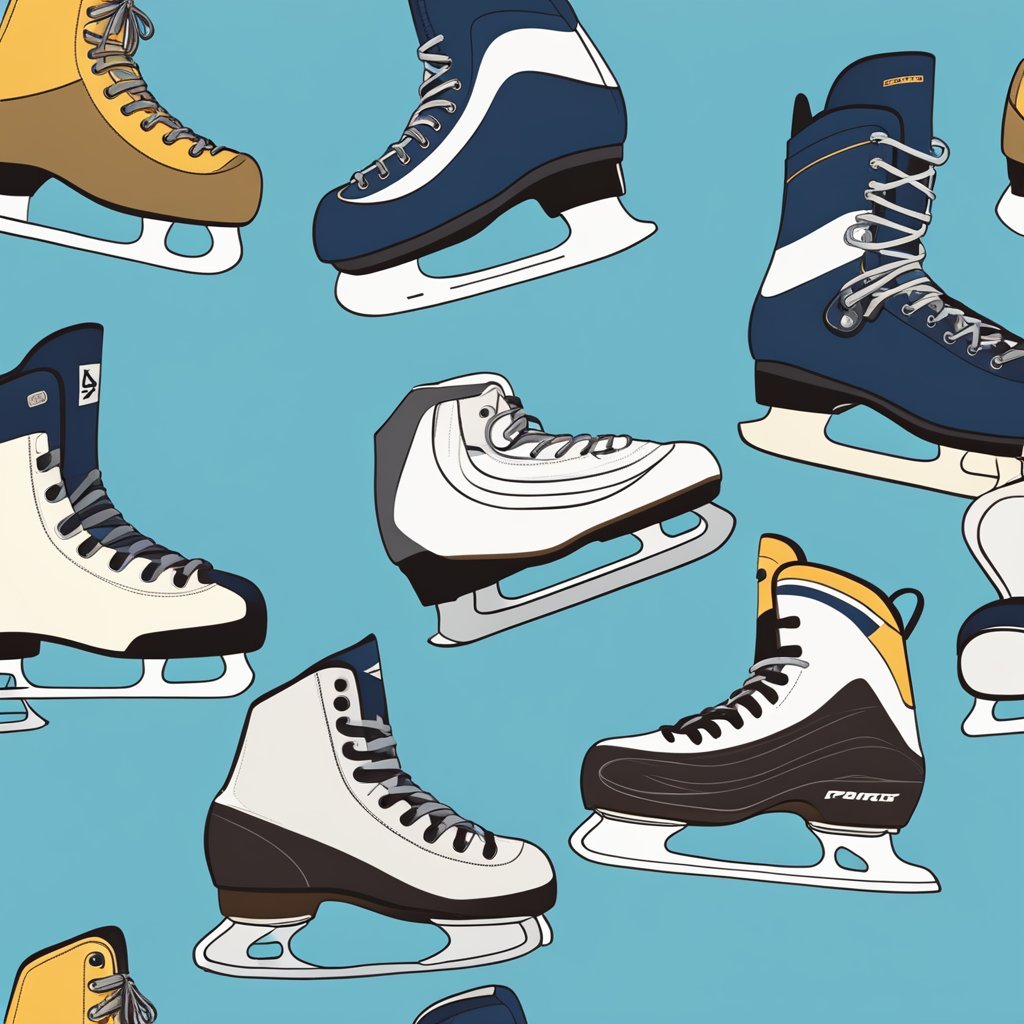
When it comes to safety and protection, both hockey skates and figure skates offer their own unique features. Hockey skates are designed to provide maximum protection to the player’s feet and ankles during the fast-paced, physical gameplay. The rigid boot of hockey skates protects the player’s feet and ankles from injuries caused by pucks, sticks, and collisions with other players. Additionally, hockey skates provide excellent ankle support, which is essential for players who make quick turns and sudden stops.
On the other hand, figure skates offer a different type of protection. The boots of figure skates are more flexible than hockey skates, allowing for greater range of motion and flexibility. However, figure skates feature a toe pick on the front of the blade, which is used for jumping and executing tricks. While the toe pick can be a useful tool for figure skaters, it can also be a hazard if not used properly. Skaters can trip or fall if they catch the toe pick on the ice, leading to potential injuries.
Both hockey skates and figure skates require proper padding to ensure maximum protection. Hockey skates typically come with thick padding around the ankle and tongue, which helps to absorb shock and protect the player’s feet from impacts. Figure skates, on the other hand, feature padding around the entire foot, providing cushioning and support for the skater’s feet.
In addition to proper padding, helmets are also essential for protecting players from head injuries. Hockey players are required to wear helmets during gameplay, while figure skaters are not. However, many figure skaters choose to wear helmets during practice sessions and competitions to protect themselves from potential falls and head injuries.
Overall, both hockey skates and figure skates offer their own unique features when it comes to safety and protection. It is important for players and skaters to choose the right type of skate for their specific needs and to always wear proper protective gear to ensure their safety on the ice.
Best Hockey Skates VS Figure Skates
| Product | Pros | Cons |
 | Customers like the ease of use, value, comfort, and versatility of the product. They mention that the buckles make it easy to get on and off, the parts are easily removable, and the shoe pad is easy to peel off. | Opinions are mixed on adjustability and quality |
 | Customers like the comfort, appearance, and fit of the roller skate. They mention that they are very soft inside, have a nice-looking design, and that they fit perfectly. | Some Customers question long-term durability |
 Jackson Ultima Figure Ice Skates for Men, Boys in Black Color | Customers like the quality, comfort, fit, appearance, and sharpness of the skates. They mention that it’s well made, the blade feels smooth, and the fit is True to size | Some Customers question long-term durability |
 | Customers like the quality, comfort, and fit of the skates. They highlighted that it is very well made, offers great ankle support, and is wide enough to not put pressure on bunions. | Few Customers question quality and so stiff to wear and uncomfortable |
 | Customers like the fit, appearance, value, and quality of the skates. They pointed that they fit just right, are pretty good-looking, and are excellent value for the money. Some appreciate the quality and comfort, saying that they are well-made, sturdy, and comfortable | Customers like the fit, appearance, value, and quality of the skates. They pointed out that they fit just right, are pretty good-looking, and are excellent value for the money. Some appreciate the quality and comfort, saying that they are well-made, sturdy, and comfortable |
Advancements in Skate Technology
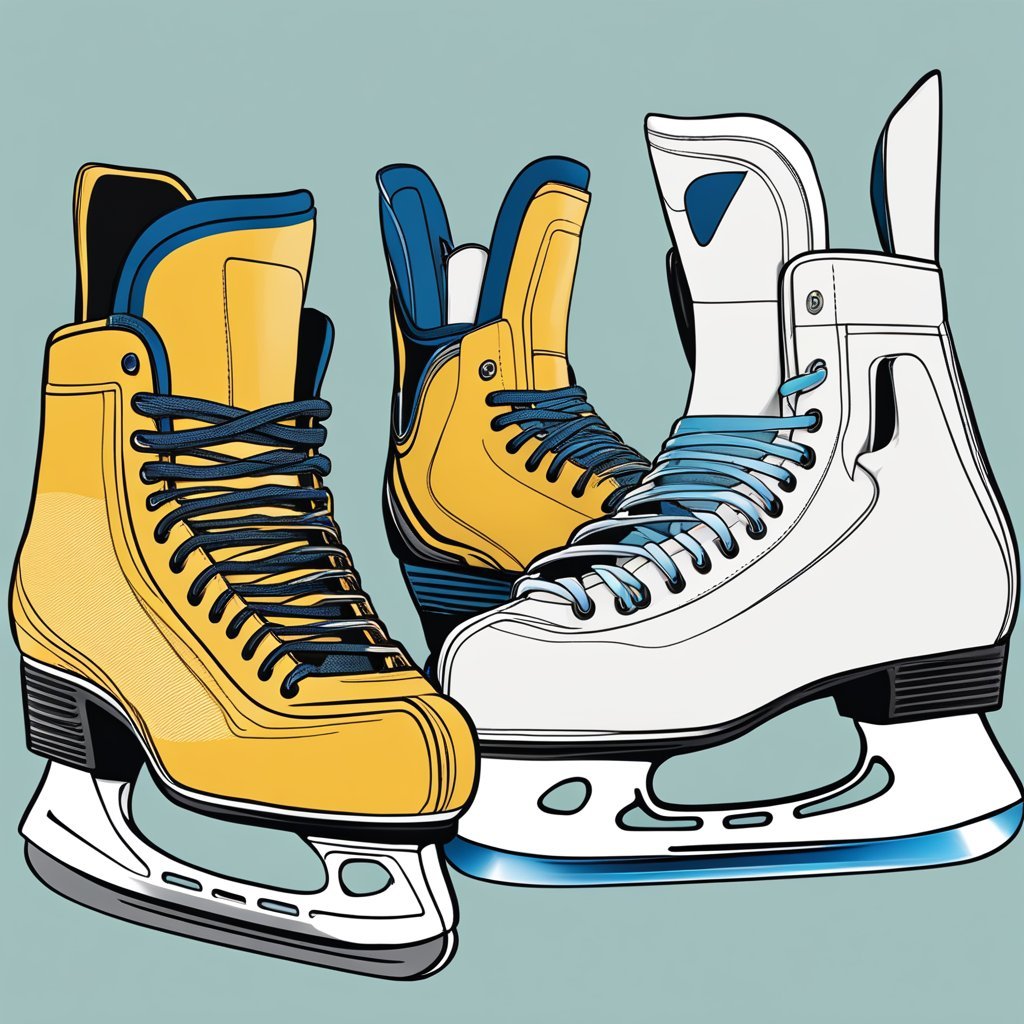
Over the years, advancements in skate technology have revolutionized the sport of ice skating. From the materials used in construction to blade design, every aspect of the skate has been improved to provide better performance and comfort to skaters.
One area where significant research has been conducted is in the construction of the boot. Manufacturers have experimented with various materials, including carbon fiber, Kevlar, and lightweight metals, to create boots that are stronger, more durable, and lighter in weight. These materials not only provide better support to the ankle and foot but also help to reduce fatigue during extended periods of use.
Another area where technology has made significant strides is in blade design. Hockey skates, for example, have a shorter, curved blade that allows for quick turns and rapid movements on the ice. Figure skates, on the other hand, have a longer, flatter blade that allows for elegant spins and jumps. The blade design is critical to the performance of the skater, and manufacturers have invested heavily in research to create blades that provide optimal performance for each type of skating.
In addition to boot and blade design, advancements have also been made in the construction of the skate as a whole. Manufacturers have developed new techniques for molding and shaping the boot to fit the foot more comfortably. They have also introduced new lacing systems that provide better support and improve the overall fit of the skate.
Overall, the advancements in skate technology have greatly improved the sport of ice skating. Skaters now have access to skates that are comfortable, supportive, and designed for optimal performance. As technology continues to evolve, we can expect to see even more improvements in the years to come.
FAQ Frequently Asked Questions

What are the main differences between hockey skates and figure skates?
Hockey skates have a shorter, more curved blade that helps with quick stops and turns. The boot is also lower, providing more flexibility for movement. In contrast, figure skates have a longer, flatter blade that aids in stability for jumps and spins. The boot is higher, providing more ankle support and allowing for more intricate footwork.
Which type of skates is recommended for beginners looking to learn ice skating?
Figure skates are often recommended for beginners because of their higher boot and ankle support, making them easier to balance on. However, hockey skates can also be used for learning basic skating skills.
Are there specific figure skates designed for children?
Yes, there are figure skates designed specifically for children. These skates are often lighter and have smaller blades to accommodate smaller feet. It is important to ensure that the skates fit properly and provide adequate ankle support for children.
Can toe picks on figure skates be used when playing hockey?
No, toe picks on figure skates are not suitable for playing hockey. The toe picks are designed for jumping and spinning in figure skating and can cause injury or damage to the ice during hockey play.
What should I consider when purchasing ice skates for recreational use?
When purchasing ice skates for recreational use, it is important to consider the fit, comfort, and support of the boot. The blade design, length, and sharpness should also be taken into account. It is recommended to purchase skates from a reputable brand and to get them professionally fitted.
How do the blade designs between hockey and figure skates affect performance on ice?
The blade designs between hockey and figure skates affect performance on ice in different ways. Hockey skates are designed for quick and agile movements, while figure skates are designed for stability and precision. The length, curvature, and sharpness of the blade all contribute to the skater’s ability to perform specific movements and maneuvers.
Final thoughts and recommendations for skaters
In conclusion, the choice between hockey skates and figure skates ultimately depends on the skater’s specific needs and preferences. If you are primarily interested in speed, agility, and quick turns, hockey skates are the way to go. On the other hand, if you are more focused on jumps, spins, and intricate footwork, figure skates are the better choice.

